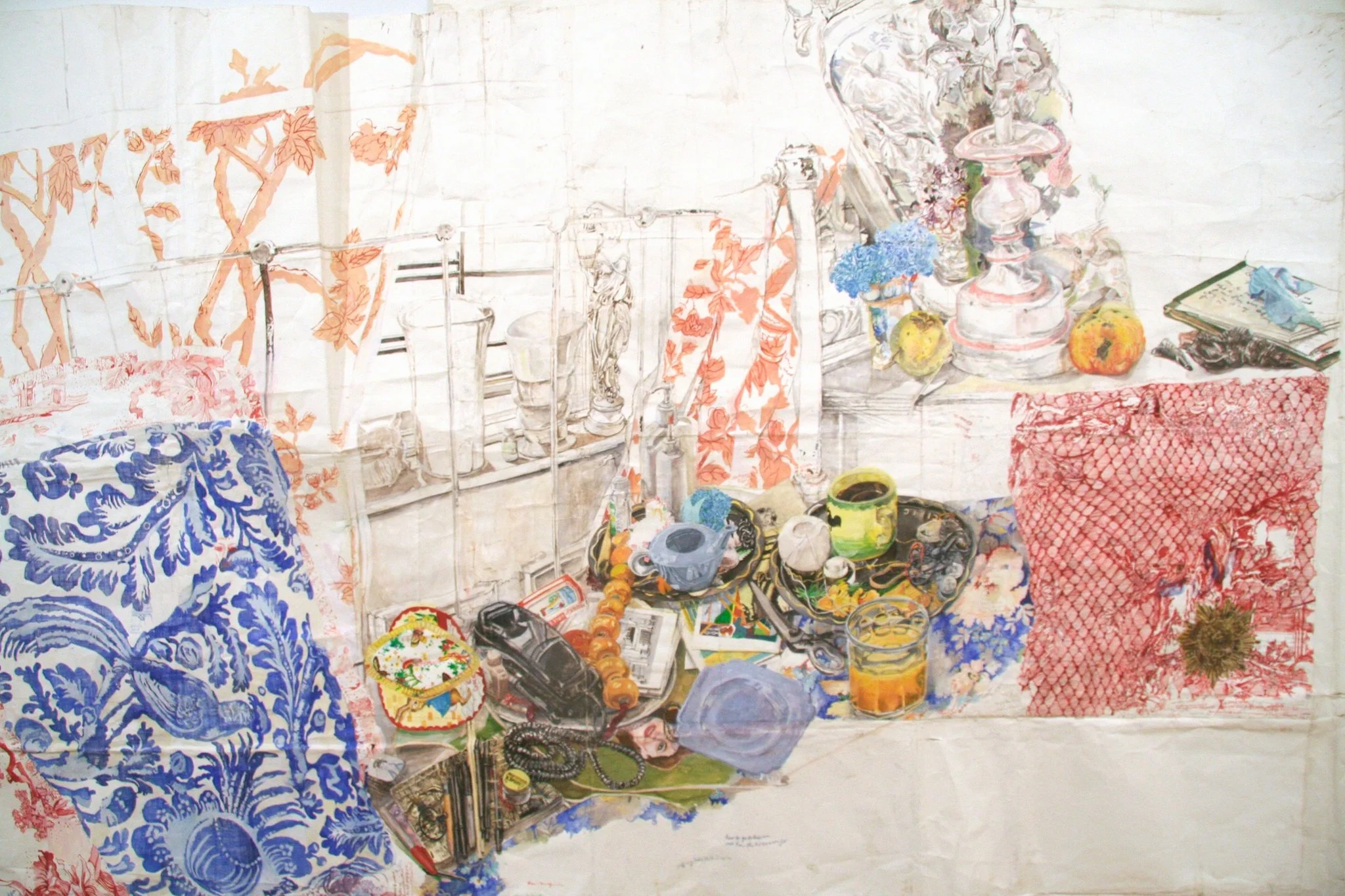Dawn Clements
Today we honor Dawn Clements (1958-2018) a contemporary artist & educator known for her large-scale panoramic drawings of interiors that were created with many different materials in a collage style. Her primary medium was Sumi ink and ballpoint pen on small to large-scale paper panels. She often cut and pasted paper together to edit and compose a completed drawing, adding paper as necessary to create the desired scale.
She describes her work as “a kind of visual diary of what [she] see[s], touch[es], and desire[s]. As I move between the mundane empirical spaces of my apartment and studio, and the glamorous fictions of movies, apparently seamless environments are disturbed through ever-shifting points of view.”
Clements began to work in her current manner back in the early ’90s when she was drawing still lifes and found herself traveling. “I was in a hotel room in Italy, drawing a telephone cord,” she recalls. “I hadn’t planned the drawing very well, and the image didn’t fit on the paper. I was disappointed until I realized that I really didn’t have to confine myself to the rectangle of the paper—that I could add on pieces to extend the image.”
“My bed pleins d’odeurs légères,” detail (2007), gouache, ballpoint pen and graphite on paper.Credit...Joe Amrhein, via Pierogi Gallery
“Once I gave myself permission to glue on more paper, I realized that I could make large drawings from smaller modules. Once the frame of the rectangle was changed, I could think of drawing in a more sculptural way, that a drawing needn’t be a ‘window’ but could present itself as the object it is.” Clements further discovered that she didn’t need to keep her growing drawing flat; when it got too long to manage, she could just fold it, which enabled her to make drawings on a much larger scale.“Sometimes my drawings get torn or worn or distressed as I fold and glue them,” she says, “but then I patch and repair them. All of this is part of my process.”
Best known for addressing issues of personal space and the portrayal of women, particularly in melodrama and film noir, Clements constantly pushed the boundaries of the paper medium, creating works ranging in size from several inches to panoramas up to seventy-eight feet wide. Her process of folding, cutting and gluing eventually distresses the paper, revealing the passage of time while giving the works a tactile and sculptural quality. “I explore intersections where the objective and subjective; truth and fiction; rational and emotive meet,” stated, Clements. “In some works, I paint/draw a continuous space that passes from inside the studio and out into the landscape. Playing with processes involving interruption, cuts, skips, and extensions, I work to see how static images might express time passage through gradual and abrupt shifts in perspective, light, palette, mark, and gesture.”
“Mrs. Jessica Drummond’s (‘My Reputation,’ 1946)” (2010), ballpoint pen ink on paper, 87.5 by 240 inches.Credit...Joe Amrhein, via Pierogi Gallery
In her drawings, Dawn Clements depicted her immediate surroundings and architectural interiors from films. She did not necessarily intend her drawings to become panoramic in scale, often beginning with a small piece of paper and paints in watercolor or black Sumi ink, or draws in ballpoint pen, a slice of what she sees. If the work seemed incomplete, she glued another section of the paper to the drawing and continues until finished. This process could go on for weeks or months, resulting in her signature panoramic drawings.
In 2016 Clements was diagnosed with early-stage breast cancer, which then spread to other parts of her body — which revealed that she had a very advanced stage [Stage IV] metastatic cancer. The day after receiving this news, Clements traveled to Rome for a scheduled two-month residency at the American Academy.
“Three Tables in Rome” (2017), watercolor on paper, 85 by 248.5 inches.Credit...Joe Amrhein, via Pierogi Gallery
During her time in Rome, she launched into a new project — a large watercolor painting consisting of three tabletops. She gave herself very specific parameters for the project. Clements began each day by cutting a piece of paper from a large roll, choosing a size that she thought she could fill that day. She vowed never to return to the previous day’s work. She’d only move forward. Clements’ self-imposed rules allowed her to understand how different levels of resolution might operate within a single work.
As she moved across and painted the tabletops, Clements added objects such as fruits, scraps of paper, and other things that she encountered in her daily life. “In the last weeks of working on this piece, I kept taking chemotherapy pills and looking at the box, saving the used blisterpacks of the pills I had consumed. I wanted to include them in the work, but I didn’t immediately do so.” She wondered if their presence would overwhelm the work and create a narrative that was too strong and maybe even too sentimental. But ultimately, she decided to include the big box of medication (Xeloda) and the empty blisterpacks. “In a way, it became a calendar, a way of counting days,” Clements says. “And I just decided that, for me, it would be dishonest not to include these objects that had become such an essential part of my life. They became as significant and as ordinary as any of the objects on the table.”
Clements died on Dec. 4 at a hospice in the Bronx. She was 60.



